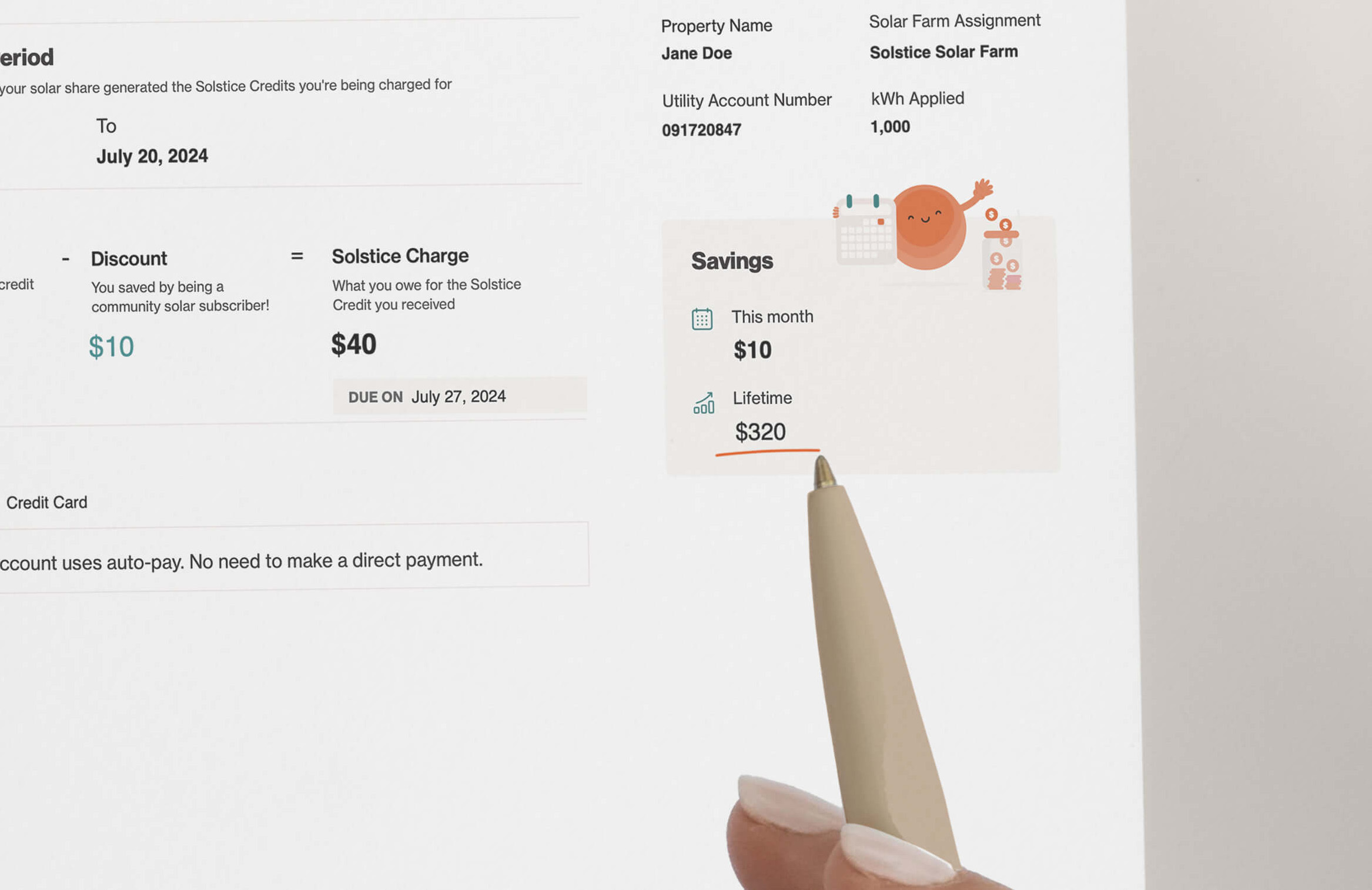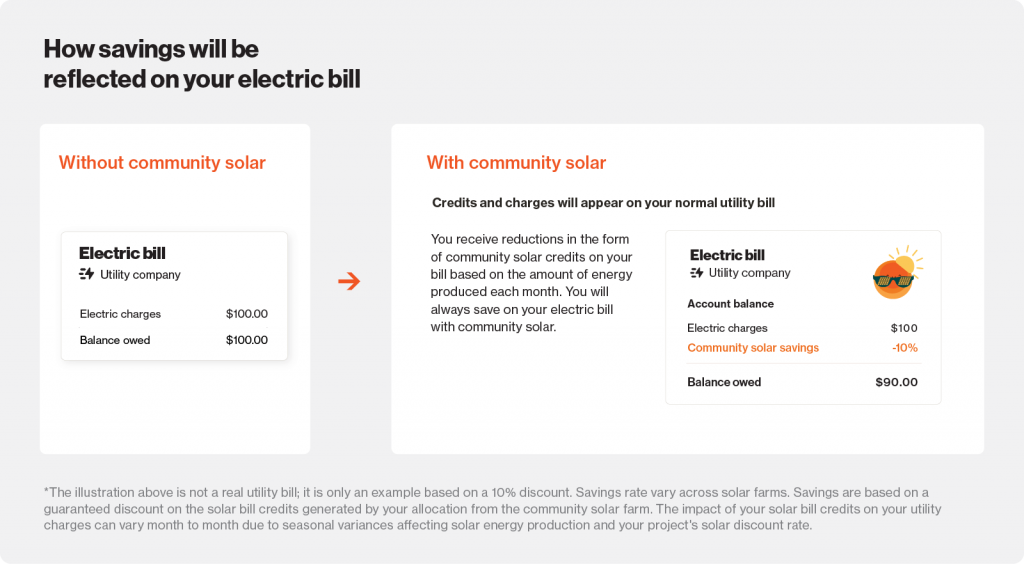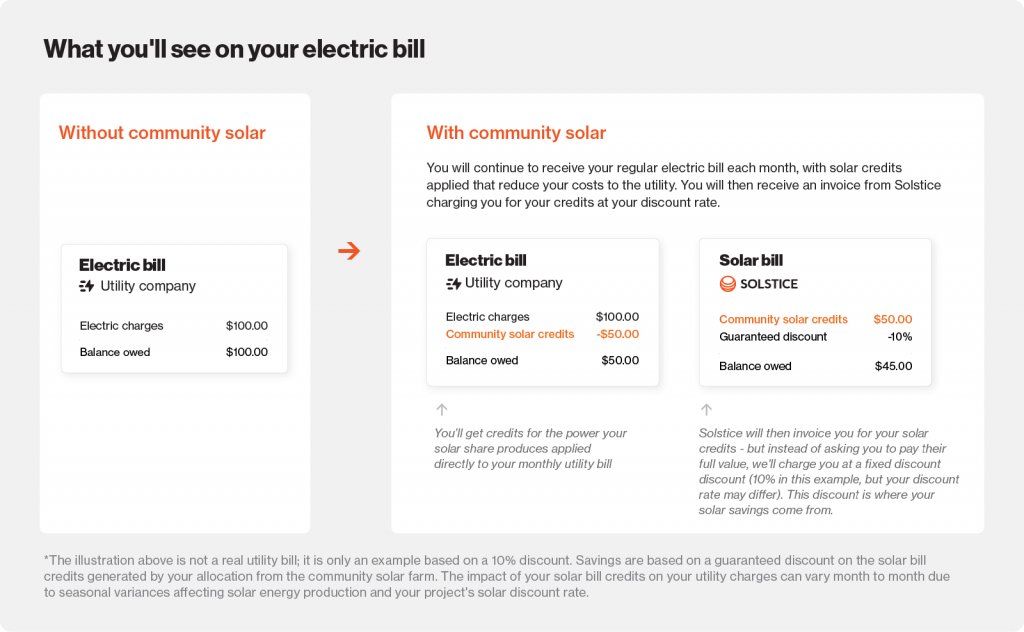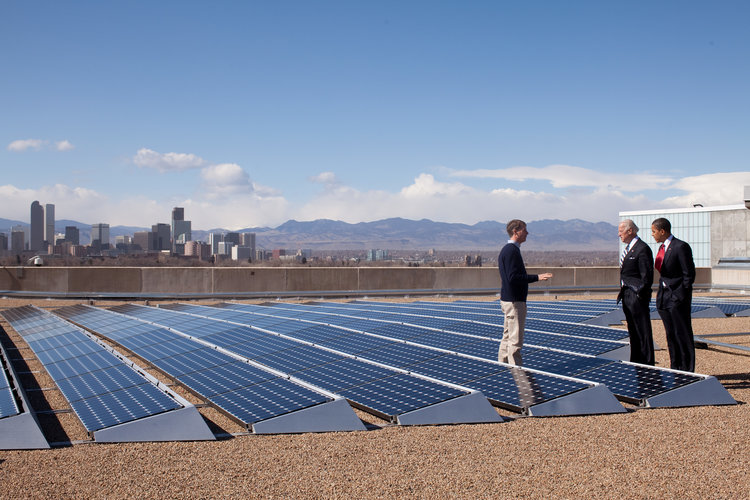Community solar offers a fantastic opportunity for everyone to enjoy the benefits of solar energy without installing panels on their rooftops – yes, that includes renters and apartment dwellers!
Savings: check. Helping the environment: check. Simple sign up: check. Easy billing… well, that depends. I’ll get back to you on that next…
I’m going to break down how community solar billing works and why it can leave some people scratching their heads. By the end I hope you understand exactly how community solar subscribers earn and pay for clean energy credits. Let me know how I did by emailing marketing@solstice.us!
How Community Solar Billing Works
Step 1: Subscribe and Earn Solar Credits
Once you’ve subscribed to a community solar project, which typically takes 5-15 minutes online, our quality control team checks over and verifies your account. This just means that we make sure you’re a real human that has the right utility provider needed to join.
Then, we take a look at your current electric bill to see how much power (ie, how many solar panels) we should allocate to your account. Once this is done, we submit your account, along with all your fellow project subscribers, to your utility company so they know you’re a community solar subscriber.
There is often a bit of time between signing up and getting savings. Your solar farm may not have turned on quite yet; we often fill projects with subscribers as they are in the process of getting built. Learn more about when your solar farm will turn on. Or, even if you join a farm that is turned on, it can take 2-3 months to start seeing community solar credits on your bill because it takes some time for your utility company to set up your account and place credits on your bills.
Once a solar farm turns on, the solar panels start generating electricity and the energy produced is credited to your utility account. These credits reflect the amount of electricity your share of the solar farm produces, which we size to match your electricity usage. You’ll see solar credits as a deduction to your monthly electric costs on your bill.
Step 2: Two Types of Billing For Your Solar Credits
Your solar credits are a deduction to your bill, but you still have to pay for them! You pay for solar credits at a discount, which can range from 5-60%, depending on your project. That’s where you save money. If your solar credits deduct $100 from your bill, and you pay for them at a 20% discount, you end up paying $80 instead of $100. In other words, you save $20 that month.
There are two ways you might be asked to pay for your credits, depending on which community solar project you join:
- Consolidated Billing: if your project uses consolidated billing, your solar credits and charges appear on your regular monthly electric bill. This way you can see your normal electric charges and the discount you received from your community solar subscription. We advocate for consolidated billing on as many projects as possible! But it’s only available in certain areas.
- Insert picture of this bill type
- Two-Bill System: commonly, community solar subscribers receive two separate bills each month – one from their utility company and another from their community solar provider. They earn credits on their electric bill, just like in consolidated billing, but they pay for their credits via a separate invoice from their community solar provider. These subscribers are still saving just as much every month, but the two bill system can make understanding these savings more difficult. Sometimes subscribers might think they are not saving, or at least find it difficult to know how much.
Any rational community solar provider like Solstice would surely opt to provide their customers with a single-bill experience, right? We wish! It’s not that easy…
Why Utility Consolidated Billing Isn’t Standard Practice
Utility Consolidated Billing (UCB), where all charges and credits are included on a single utility bill, would make all of our lives easier. However, UCB is not standard practice across the U.S. for several reasons:
- Regulatory Barriers: Different states have varying regulations regarding how utilities and community solar projects can interact. Some states haven’t even adopted the necessary legislation to allow for community solar at all, let alone consolidated billing for when they eventually do.
- Utility Resistance: Utilities might resist UCB because it requires them to modify their billing systems and processes, and that is no easy task. Getting buy-in from all the parties involved can take years.
- Complexity of Implementation: Integrating billing systems between utilities and community solar providers is complex. It requires significant coordination and data sharing, which can be technologically and administratively challenging. Some of the early utilities to adopt UCB have seen hurdles administering it properly (though we’re working on this!).
Understanding the Consolidated Billing System
Here’s how the consolidated billing system works:
- Utility Bill: Your utility bill will show your total electricity usage, and it will include the community solar credits (savings) generated by your community solar subscription directly on the same bill. The credits will reduce your overall utility bill, making it more straightforward and convenient.
- Community Solar Charges: Instead of receiving a separate bill for your community solar credits, the charges for the solar credits will be included directly on your utility bill at a discounted rate compared to standard electricity prices.
Understanding the Two-Bill System
Here’s how the two-bill system works:
- Utility Bill: This bill will show your total electricity usage minus the credits (savings) generated by your community solar subscription. The credits reduce your overall utility bill. Always. This is exciting!
- Community Solar Bill: This bill, sent separately (usually 1-2 months after your credits have discounted your utility bill) by the solar project manager (that’s us!), charges you for the solar credits at a discounted rate compared to standard electricity prices.
Woah woah woah – I thought I was saving with you guys. Why are you charging me now?
Yep, we thought you’d say that. Here’s where it can be a little confusing. Stay with me!
- Imagine your usual electricity bill is $100. When you join a community solar program, you get a credit of $50 for using shared solar power. This means you only pay $50 to your usual electricity company. However, because you are part of the community solar program, you also pay Solstice for the solar power you used. If the program offers a 20% discount, you pay $40 instead of $50. So in total, instead of paying $100, you pay $50 to your electricity company and $40 to the solar program, making your total $90. This way, you save $10!
Is it confusing? A little. Might it be annoying to get two bills? Admittedly so. Are you saving money every month? YES.
Why Is Community Solar Billing Confusing?
1. Multiple Bills
Receiving two different bills can be a hassle. The utility bill shows the credited amount, but you must pay separately for those credits to the solar provider at a discount. Managing these two bills adds complexity and honestly, I’m not so hot at math… that’s why I write blog posts for a living. The good news is that if you ever want to walk through your bill and get some help breaking down the credits and savings, a Solstice customer success representative (who almost certainly is good at math) can hop on a call with you any time to explain your bill and savings.
2. Fluctuating Credits
The amount of solar credits you receive can vary monthly based on your share’s energy production and seasonal changes. This fluctuation can make it challenging to predict your exact savings and easily see the exact financial benefit each month. So, if you’re looking for that exact $10 savings, you might find yourself confused again. Your savings is all based on how much energy was created that month, how much you used, etc. We aim to evenly distribute savings month to month, but there is always a little variance.
3. Inconsistent Terminology
Utilities use different terms for solar credits on bills. For example, in New York, you might see a line item for “CDG Value Stack Credit,” while in Massachusetts, it could be listed as “net metering” or “NEM.” The inconsistency (and jargon) can make it difficult for subscribers to identify their credits. The good news is that we keep very close communication with utilities we work with so that we can stay on top of new terminology or charges that our customers may have printed on their bills.
Our Commitment to Simplifying Community Solar Savings
The complexity of managing multiple bills and dealing with fluctuating credits can be overwhelming and downright stressful for those of us with limited time. Even when you’re saving $300+ annually, the effort required to maintain multiple payments can make the savings seem not-so-worth-it.
One way Solstice makes this process easier is by enrolling dual bill customers in autopay – that way, you only have to deal with one bill from your electricity provider, Solstice will alert you about one week before your second bill is due, and then automatically withdraw the correct amount on its due date. You get your savings, and you don’t have to worry about paying the second bill on time.
As a community solar company, we understand that receiving two bills can be a pain. However, we firmly believe that the benefits of community solar—saving money and reducing climate change—are worth the hassle. Even with the dual billing system, the combined total of your bills will still reflect savings compared to standard electricity rates.
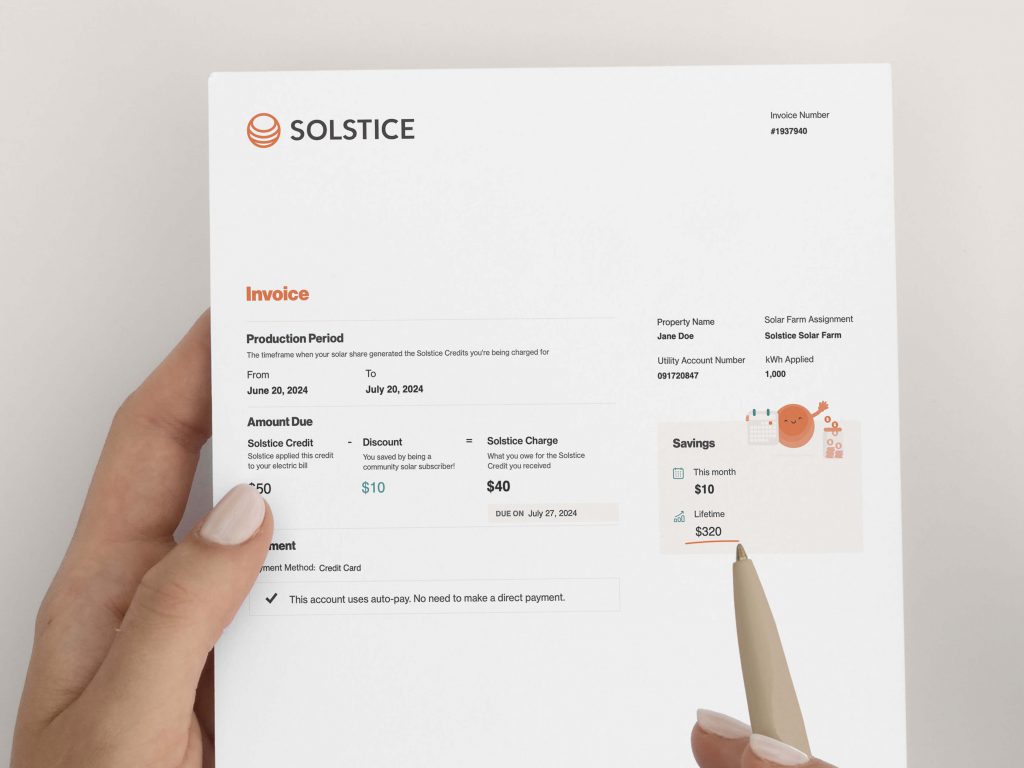
We’re committed to advocating for more widespread adoption of Utility Consolidated Billing (reminder: that’s the one bill model) to make community solar more accessible and less confusing for everyone. In the meantime, if you are on a two-bill project, we strive to provide clear information and support to help you navigate your bills and track your savings, ensuring you reap the full benefits of your community solar subscription. We have one of the best customer success teams in the business, and they are truly phenomenal at helping our subscribers understand their bills and feel confident that they are making a difference for our planet.
